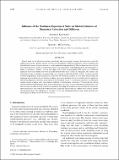| dc.contributor.author | Klocker, Andreas | |
| dc.contributor.author | McDougall, Trevor J. | |
| dc.date.accessioned | 2011-05-06T20:07:36Z | |
| dc.date.available | 2011-05-06T20:07:36Z | |
| dc.date.issued | 2010-08 | |
| dc.date.submitted | 2009-06 | |
| dc.identifier.issn | 0022-3670 | |
| dc.identifier.issn | 1520-0485 | |
| dc.identifier.uri | http://hdl.handle.net/1721.1/62598 | |
| dc.description.abstract | Recent work on the global overturning circulation and its energetics assumes that processes caused by nonlinearities of the equation of state of seawater are negligible. Nonlinear processes such as cabbeling and thermobaricity cause diapycnal motion as a consequence of isopycnal mixing. The nonlinear equation of state also causes the helical nature of neutral trajectories; as a consequence of this helical nature, it is not possible to define a continuous “density” surface that aligns with neutral tangent planes. The result is an additional diapycnal advection, which needs to be accounted for in water-mass analysis. In this paper, the authors take advantage of new techniques in constructing very accurate continuous density surfaces to more precisely estimate isopycnal and diapycnal processes caused by the nonlinear equation of state. They then quantify the diapycnal advection due to each of these nonlinear processes and show that they lead in total to a significant downward diapycnal advection, particularly in the Southern Ocean. The nonlinear processes are therefore another source of dense water formation in addition to high-latitude convection. To maintain the abyssal stratification in the global ocean, these dense water masses have to be brought back toward surface layers, and this can occur by either diabatic or adiabatic processes. Including these nonlinear processes into the advection–diffusion balance, the authors show that observed diapycnal diffusivities are unlikely to be able to support the amount of dense water produced in the global ocean, thus placing more importance on the adiabatic way of bringing the deep waters back to the surface. | en_US |
| dc.language.iso | en_US | |
| dc.publisher | American Meteorological Society | en_US |
| dc.relation.isversionof | http://dx.doi.org/10.1175/2010jpo4303.1 | en_US |
| dc.rights | Article is made available in accordance with the publisher's policy and may be subject to US copyright law. Please refer to the publisher's site for terms of use. | en_US |
| dc.source | American Meteorological Society | en_US |
| dc.title | Influence of the Nonlinear Equation of State on Global Estimates of Dianeutral Advection and Diffusion | en_US |
| dc.type | Article | en_US |
| dc.identifier.citation | Klocker, Andreas, Trevor J. McDougall. (2010) "Influence of the Nonlinear Equation of State on Global Estimates of Dianeutral Advection and Diffusion." Journal of Physical Oceanography 40:8, 1690-1709.© 2010 American Meteorological Society. | en_US |
| dc.contributor.department | Massachusetts Institute of Technology. Department of Earth, Atmospheric, and Planetary Sciences | en_US |
| dc.contributor.approver | Klocker, Andreas | |
| dc.contributor.mitauthor | Klocker, Andreas | |
| dc.relation.journal | Journal of Physical Oceanography | en_US |
| dc.eprint.version | Final published version | en_US |
| dc.type.uri | http://purl.org/eprint/type/JournalArticle | en_US |
| eprint.status | http://purl.org/eprint/status/PeerReviewed | en_US |
| dspace.orderedauthors | Klocker, Andreas; McDougall, Trevor J. | en |
| dc.identifier.orcid | https://orcid.org/0000-0002-2038-7922 | |
| mit.license | PUBLISHER_POLICY | en_US |
| mit.metadata.status | Complete | |
